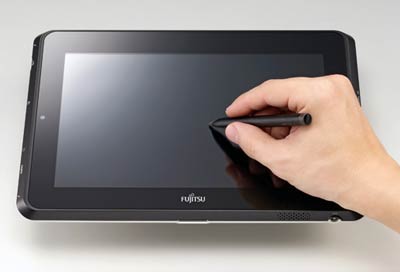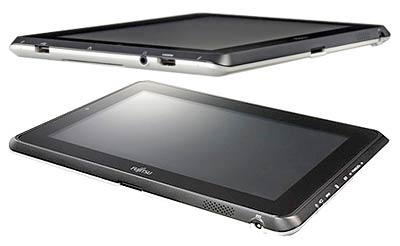On February 24, 2011, Fujitsu announced the Stylistic Q550, which the company calls a "business-class slate PC." The Q550 is a small Windows 7-based, Intel Atom-powered tablet with a 10.1-inch wide-format display. It is clearly designed to serve as Fujitsu's initial entry in the hugely promising, but as of yet quite loosely defined, media tablet market dominated by Apple's iPad.

Scheduled to be available around April 2011, the Q550 will face a market that Fujitsu once dominated with its pen slate and tablet designs going back to the early 1990s. Most recently, we were impressed with the design, high quality, and overall execution of the Stylistic ST6000 Series of Tablet PCs, the successor to a long line of ST5x00, ST4000 and earlier Stylistic pen computing slates (see Fujitsu's tablet history here). However, that was then and this is now. Fujitsu stopped selling tablets in recent years and instead concentrated on a line of convertible Tablet PCs such as the LifeBook T5010, T4410, T2010, and ultra-mobile convertibles such as the LifeBook U820.
While those convertible LifeBooks were (and are) very nice, they represent low volume niche products compared to the emerging tablet market where Apple sold well over 10 million iPads in 2010 alone, and market research firms such as DisplaySearch and iSuppli predict staggering numbers of tablet sales (in the hundreds of millions over the next three to four years). This should present a formidable opportunity for a company as experienced in the tablet form factor as Fujitsu. So what does Fujitsu offer with the Stylistic Q550?

The hardware itself is standard tablet fare, combining the uniquitous iPad look with a flush black front and silvery back with some more traditional Japanese electronics design elements. The display size is 10.1 inches diagonally, but Fujitsu chose the 16:10 wide format over the traditional 4:3 aspect ratio of the iPad and HP's upcoming TouchPad. Resolution is 1280 x 800 pixel, i.e. a bit higher than the iPad's standard 1024 x 768 pixel XGA. The display has anti-glare treatment, a wide 160 degree vewing angle from all directions, and claims outdoor viewability with a strong 400 nits LED backlight.

One area where the Stylistic Q550 trumps the iPad is in its available N-trig DuoSense dual input that combines capacitive multi-touch with an an active pen. It's an auto-sensing arrangement that automatically switches between touch and pen. Having a pen for applications and tasks that require precise input or drawing is a big advantage, and it certainly also comes in handy operating the mouse-oriented Windows 7 user interface. The pen, though, is different from the ubiquitous Wacom pen in that it does need a battery. It's a tiny AAAA that is said to last about a year and a half.
The Q550 measures 10.8 x 7.6 inches and it is 0.64 inches thick—just a bit larger than the iPad's 9.6 x 7.5 x 0.5 inches. Weight, with the standard battery, is 1.6 pounds for the version that includes both touch and pen, also roughly the same as the iPad. That however, is only true if you use the modest standard battery which packs just 13 watt-hours and is good for only 3.5 hours of operation. The optional 38 watt-hour high-capacity battery adds a third of a pound and presumably some size, and that battery is needed to match the iPad's phenomenal ten hour battery life.
Now what do we have under the hood? That was originally an unspecified "next generation Intel Atom" processor, that turned out to be a 1.5GHz Atom Z670. Memory is up to 2GB of DDR2 SDRAM, and you can get either a 30 or 62GB solid state disk. There's a USB port, a standard 3.5mm audio jack, docking port and two cameras. At 0.3 megapixel front and 1.3 megapixel rear they are fairly low-res, but workable. There's WiFi and Bluetooth, and also optional Gobi 3000 with GPS, which means carrier and communications technology independence.
The Q550 runs Windows 7. In the past, the choice of operating system would not even have been an issue, but now it is. Apple's iOS showed that a touch-optimized dedicated tablet OS with small apps fills the needs of millions. Google's Android is the OS of choice for most non-Apple smartphones and is rapidly building steam in tablets with an approach that copies Apple's touch orientation but adds more PC-style configurability. HP's TouchPad uses the highly regarded webOS Palm pioneered on its Pre smartphones, and webOS, too, is totally touch-optimized. Microsoft, in the meantime, still does not have a clearly communicated tablet strategy, and Windows 7 is the same Windows that runs on keyboard/mouse-based desktops and notebooks. But Windows is Windows, and there's no denying the many advantages of that approach: a giant selection of industrial strength software, programming and integration leverage, good security, and general compatibility with everything else in an existing IT infrastructure.
How about ruggedness? Not much information here. Japanese companies are notoriously conservative with their environmental specs, and so the Q550 is listed with a rather narrow 41 to 95 degree operating temperature range and nothing more. That is a bit limiting in a business-class market, especially when the competition generally aims to offer semi-ruggedness.
Price has always been an issue with tablets. Initially that wasn't much of a problem as tablets were viewed as very specialized vertical market products with a price to match. That changed some with Microsoft's 2002 Tablet PC initiative that brought tablets and convertible notebooks more into the mainstream, but prices were still high by current notebook standards. The advent of the iPad again changed the pricing structure, with pricing now excepted to be in the hundreds of US dollars, and not in the thousands. Fujitsu meets that challenge with a starting price under US$800.
But will all this be enough? The direct competition for the Stylistic Q550 is not the iPad, but products like Motion Computing's CL900 tablet that was announced the beginning of 2011. While the Motion tablet is based on the same Intel Atom/Windows 7 combo as the Q550, it offers significant ruggedness on top of a more powerful battery, much higher resolution cameras, and snap-on peripherals at a price that starts under US$1,000. And then there's the Motorola Xoom, the RIM PlayBook, and a growing number of increasingly competent tablets that all seek to cash in on the iPad's immense popularity.
So for now, immaculate Fujitsu pedigree nothwithstanding, the Q550 is facing a difficult challenge. There's a lot of good stuff here—like the auto-sense dual input, security, fingerprint reader, etc.—and Fujitsu certainly knows its markets, so welcome back to the tablet party, Fujitsu.
Note: As of March 2012, Fujitsu is offering a top-of-the-line model of the Q550 with a 1.7GHz Intel Atom Z690 instead of the original 1.5GHz Z670. This model, which starts at US$999, also comes standard with a Gobi3000 technology and carrier-independent WWAN module (available as an option in lesser versions).
And in mid-2012, Fujitsu updated the device once again, naming it it the Q552. The main difference is a switch to the quicker dual-core 1.6GHz Intel Atom N2600.



